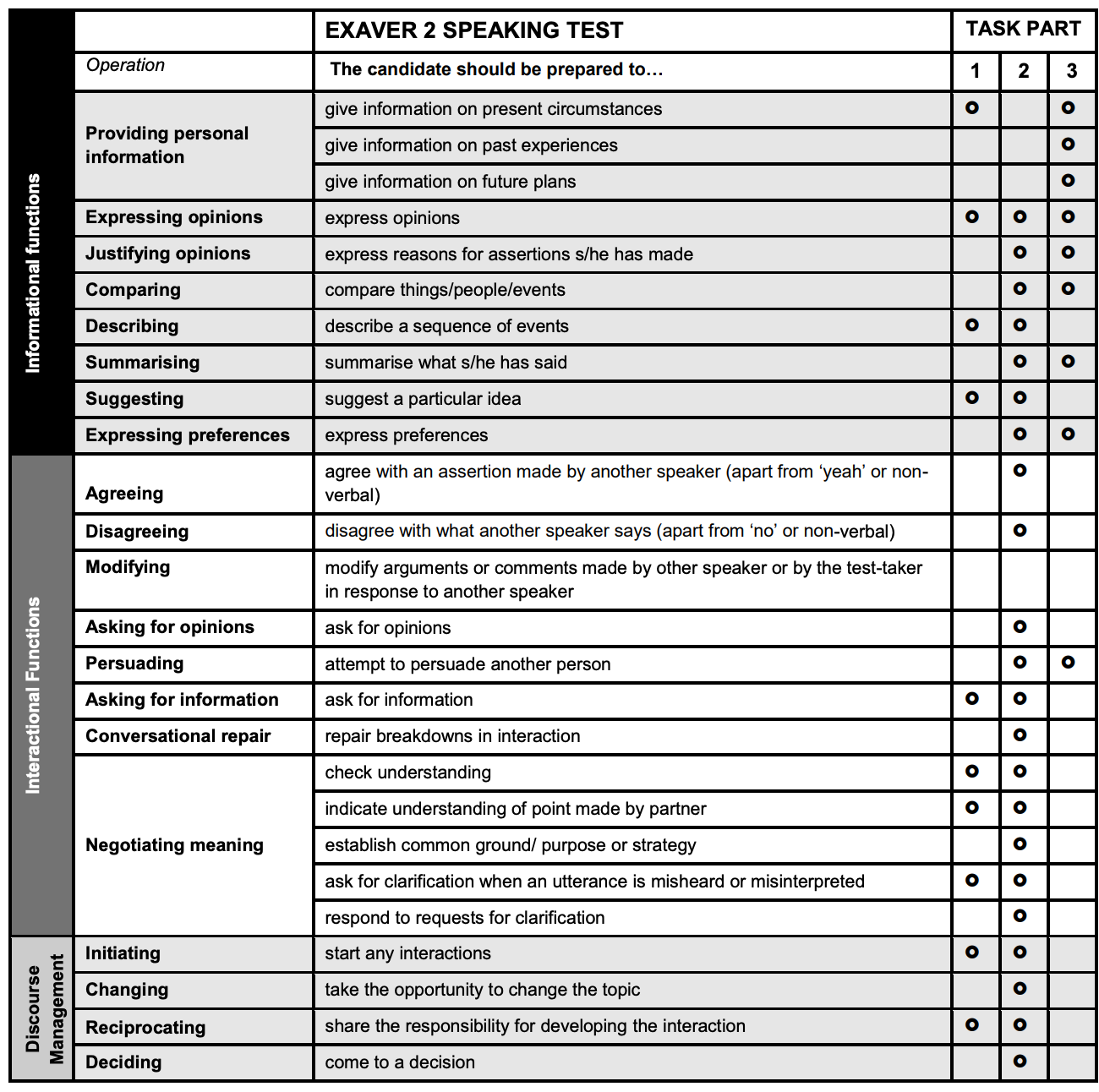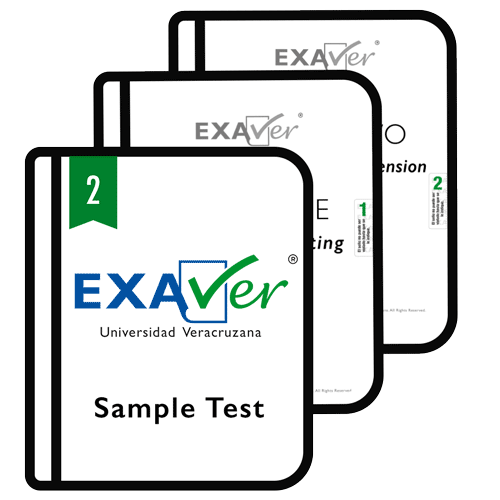Guide for candidates EXAVER 2
General Information
EXAVER 2 is the second in a series of three General English proficiency tests developed by Universidad Veracruzana. It is not based on any specific textbook or course syllabus. The exam follows the general principles of the Council of Europe’s Threshold 1990 document and aligns with ALTE Level 2, corresponding to the Preliminary English Test (PET) offered by Cambridge English (UCLES). EXAVER 2 corresponds to the B1 level of the Common European Framework of Reference for Languages (CEFR). This means that candidates who successfully pass this exam demonstrate an intermediate level of English proficiency.
Test Format
EXAVER 2 is a paper-based test comprised of three components (Papers).
Anchor Test
At the beginning of the exam, all candidates take an Anchor Test. This Anchor Test lasts ten minutes. This test is administered before Paper One and is used to ensure scoring consistency and comparability across different test versions, based on the levels of the Common European Framework of Reference for Languages CEFR (2001, 2018, 2020).
Paper One: Reading & Writing
This paper assesses reading and writing skills. It lasts sixty minutes and includes forty items. According to the CEFR (2001, 2018, 2020), candidates at B1 level should be able to:
- Read factual texts on familiar subjects with a good level of comprehension.
- Understand events, feelings, and wishes described in personal letters.
- Understand personal correspondence providing relatively detailed accounts of experiences.
- Identify key information in everyday texts such as brochures, letters, and short official documents.
- Scan longer texts to locate specific information and synthesize content from multiple sources.
- Understand main points in reviews of films, books and concerts, among others.
- Produce extended texts by sequencing and linking shorter segments.
Paper Two: Listening
This paper assesses listening comprehension. It includes twenty-one items and takes approximately thirty-five minutes. According to the CEFR (2001, 2018, 2020), a candidate at B1 level is expected to:
- Understand the main ideas in clear, standard speech on familiar topics.
- Follow most everyday conversations and discussions when clearly articulated.
- Distinguish between main ideas and supporting details in familiar contexts.
- Understand the essential content of short news segments and recordings delivered at a moderate pace.
- Grasp key details in narratives such as holiday descriptions or personal stories.
| Paper Two (Listening) | ||||
|---|---|---|---|---|
| Section | Questions | Type of item | Description | Timing |
| 1 | 1 - 5 | Multiple choice |
|
35 minutes approx. |
| 2 | 6 - 10 | Multiple choice |
|
|
| 3 | 11 - 16 | Multiple choice |
|
|
| 4 | 17 - 21 | Gap filling |
|
|
Paper Three: Speaking
This paper evaluates your speaking ability. The interview lasts approximately thirteen minutes per group and is conducted with two or three candidates at a time, depending on scheduling and availability. According to the CEFR (2001, 2018, 2020), at B1 level you should be able to:
- Talk about familiar topics by linking ideas in a sequence.
- Describe experiences, feelings, and reactions.
- Narrate events and provide explanations for opinions or actions.
- Participate in everyday conversations and respond appropriately to follow-up questions.
Below you will find a table summarizing the contents of Paper Three:
| Paper Three (Speaking) | ||||
|---|---|---|---|---|
| Part | Type of item | Description | Timing | |
| 1 | Greetings and introductions |
|
13 minutes per pair | |
| 2 | Communicative activity |
|
||
| 3 | Extended responses |
|
||
Test Contents
In this section you will find a description of the language proficiency level that EXAVER 2 candidates should have based on:
- The topics candidates are expected to handle.
- What they are expected to be able to do with the language (general functions).
- The grammatical structures they should know.
1) Topics
The contexts within which the above abilities take place may be:
- personal life, home, family
- community and social relations
- current events
- weather
- work and/or studies
- leisure activities and interests
- travel, places of interest, different countries
- shopping
- eating out
- personal information
- house and home
- daily activities, including work and study
- travel and holidays
- family relations
- health/education
- food and drink
- clothing/shopping
- giving directions to places
- lenguaje/services
2)Language purposes for EXAVER 2
A candidate for the EXAVER Level 2 exam should be able to carry out everyday transactions, for which he/she has to demonstrate his/her ability to ask for repetition, clarification and explanation in written or spoken mode, in a variety of contexts like:
- with immigration/security officers, police, officials.
- while making arrangements for accommodation, meals.
- during situations arising while shopping/buying consumer goods.
- during situations arising related to the use of public transportation.
- using information services/visiting public places.
- offering and accepting private hospitality.
- using private transportation/using public services.
- seeking/using educational services.
- finding the way.
- communicating at work.
- offering and accepting private hospitality.
3)Language functions
EXAVER 2 candidates are expected to be able to:
- give and get factual information.
- express and find out attitudes (agree, disagree, express probability, certainty, preference, intention, regret, sympathy, satisfaction, dissatisfaction, fear, surprise, disappointment, approval, gratitude.
- get things done (suggest, advise, warn, instruct, ask for help, invite, accept and decline invitations).
- socialize (greet, address people, introduce, take leave).
- structure and repair communication (ask for clarification, introduce a topic, correct oneself, summarize, exemplify, ask for help, paraphrase, ask for spelling, close a conversation).
4) Wordlist
For a complete wordlist see Threshold 1990, pp157-177.
5)Language structures
At this level it is expected that candidates know structures like:
- Verb to be
- Imperative
- Simple present: affirmative, negative interrogative: for states and habits transitive and intransitive forms
- Present continuos: affirmative, negative, interrogative: for present actions and future plans
- Simple past: affirmative, negative, interrogative: past events
- Present perfect: affirmative, negative, interrogative
- Past continuos: affirmative, negative, interrogative: interrupted actions, parallel past actions
- Simple future: offers, promises, predictions
- Going to -idiomatic future: future plans / intentions.
- Present perfect: recent past, general experience, unfinished past
- Past perfect: narrative, reported speech
- Adverbs manner / frequency / time degree / direction / sequence comparative and superlative forms
- Imperatives
- Passive voice structures: present, past simple, + infinitive (I prefer my fish to be fried), with should (I think we should be told!)
- Adjectives: attributive / predicative / participial colour, size, shape, quality, nationality, cardinal and ordinal numbers
- Verb phrases, such as: I want to dance / I enjoy swimming
- Possessive adjectives: physical attributes / characteristics physical qualities of objects / moral qualities of animates emotional states / probability quantitative / some / any / many / much/ a few / a lot of / all / a little / lots of / regular
- Modals: can, could, would, will, shall, should, may, might, have (got) to, ought to, must, mustn’t, need, needn’t, used to + infinitive
- Reported statements and questions using 'say', 'ask', 'tell'
- Pronouns: subject pronouns, object pronouns, reflexive pronouns, possessive pronouns, indefinite pronouns, relative pronouns, demonstrative pronouns, identifying.
- Impersonal pronouns: there is / there are / genitive (and apostrophe).
- Conjunctions
- Prepositions: time, position, distance, (at, in, on) direction, origin, duration, anteriority, posteriority, frequency, manner, agency, instrumentality, benefaction, possession, inclusion, exclusion, similarity see: threshold 1990, p.132/133 for complete list
- Verbs used as subjects and irregular comparative forms of adjectives / regular and irregular superlative forms of adjectives.
- Conditional structures: type 0, type 1, type 2
- Determiners: indefinite article "a", for unspecified persons/things (there is a man at the door), to specify frequency (twice a day), to designate amount (15 pence a kilo), Definite article “the”, pre- and post-determiners
- Gerund as present participle
Summary of Functions for EXAVER Level 2 Speaking Test

Sample Test
Below, there is a downloadable sample booklet to familiarize yourself with the structure and content of the EXAVER 2 exam (B1 level). This booklet includes a full-length sample test that reflects the actual format and difficulty of the official exam. You will also find the Answer Sheet to practice marking your answers under exam conditions, the Audio File for Paper Two (Listening) to complete the listening section just as you would during the real test, and the Answer Key to check your responses and self-assess your performance. These resources are designed to help you prepare effectively and evaluate your current level of English. We recommend using them under timed conditions to simulate the test experience.
Paper Three
Watch the video below to see a real example of how Paper Three (Speaking) is administered during the EXAVER 2 exam (B1 level). In this video, you will observe how the interaction unfolds between the examiner and the candidates across the three parts of the speaking component. The video will help you to understand the format and timing of each part of the test.
Aviso legal
Todo el contenido disponible en este sitio web (incluyendo booklets de exámenes, audios, información específica de cada sección del examen, hojas de respuesta, claves de respuestas y los videos de muestra del Paper Three, entre otros) constituye propiedad intelectual exclusiva de la Universidad Veracruzana y se encuentra protegido por la legislación nacional e internacional en materia de derechos de autor y propiedad industrial. Queda estrictamente prohibida su reproducción, distribución, modificación, venta o utilización con fines comerciales, incluidos cursos o talleres de preparación ajenos a esta institución, sin autorización previa y por escrito de la oficina del Abogado General de la Universidad Veracruzana. El uso indebido de los contenidos en este sitio web, en contravención a los términos establecidos, podrá dar lugar al ejercicio de las acciones legales correspondientes, tanto civiles como penales, por parte de la Universidad Veracruzana. El uso del material de preparación tiene fines exclusivamente informativos y de preparación individual para el Examen de Certificación de Lengua Inglesa EXAVER. Se recomienda a los usuarios presentar dicho examen únicamente si obtienen un desempeño superior al 80% de aciertos en el Sample Test. Es responsabilidad del sustentante asegurarse de contar con el nivel de competencia necesario, ya que para acreditar el examen se deben aprobar las cuatro habilidades evaluadas (Comprensión y Expresión Oral, y Comprensión y Expresión Escrita). El reprobar una sola habilidad implica la no acreditación del examen. Asimismo, el Sample Test únicamente proporciona información sobre tres de las cuatro habilidades; por ello, se sugiere ver el video de muestra del Paper Three para conocer el formato y criterios de evaluación de la entrevista antes de presentar el examen. Este sitio web y su contenido se rigen por las leyes mexicanas. Cualquier controversia relacionada con su uso será competencia de los tribunales de la ciudad de Xalapa, Veracruz, México. Para cualquier consulta relacionada con este sitio o el contenido aquí publicado contáctenos en exaver@uv.mx.
